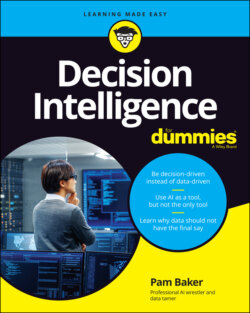Читать книгу Decision Intelligence For Dummies - Pamela Baker - Страница 31
Seeing How Decision Intelligence Looks on Paper
ОглавлениеThough the decision intelligence framework is perfect for guiding AI to consistently produce business value for you, the methodology can be used with no digital data or machines. For example, you can use AI to make decisions on a spreadsheet, on the back of a napkin, on a single sheet of paper, or even on a wall (using a crayon, of course). That’s because the process you use is up to the decision-maker to choose. The Decision Intelligence process itself can be quick and short, or it can be quite complex and take some time to complete. You may want to start with a SWOT table listing the Strengths, Weaknesses, Opportunities, and Threats when making your initial decision. From there, you can determine the steps you need to take to make your decision render a desired impact in the real world.
The process is similar to determining a destination and then mapping out the best route between where you are and where you want to be. It’s the impact you desire, however, that will define which route is best. Need to be there fast? The direct route is best. Want to see more along the way or stop at tourist attractions? Then a scenic route is the best way. Want to use your hotel rewards points or your gas rewards card on the trip? Then mapping a route based on the location of certain hotel and gas brands is the best route.
In decision intelligence, the impact always matters most, for it is the manifestation of your decision.
Working within a decision intelligence framework forces you to become more aware of how the decision-making process works. For example, many of the mental processes you use are intuitive — that's what makes it possible for you to come to conclusions quickly. But make no mistake: Whether you realize it or not, your brain is calculating the same mathematical formulas as a machine would use to help you reach the same conclusions. There’s a simple reason for that: Machines copy how people think. As such, machines are definitely the sidekicks in decision intelligence processes, there to assist and augment your efforts.
Superheroes don’t always need a sidekick, and you won’t either. Choose the processes, tools, and information according to the needs in executing your decision. Don’t default to the technologies and queries with which you’re most familiar. The point is not to repeat the same acts, but rather to produce consistent value in personal, professional, or digital decisions.
